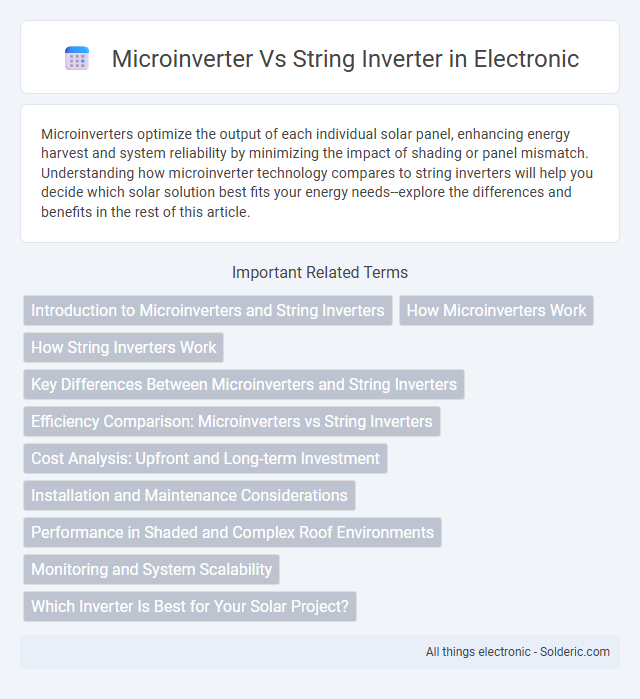Microinverters optimize the output of each individual solar panel, enhancing energy harvest and system reliability by minimizing the impact of shading or panel mismatch. Understanding how microinverter technology compares to string inverters will help you decide which solar solution best fits your energy needs--explore the differences and benefits in the rest of this article.
Comparison Table
| Feature | Microinverter | String Inverter |
|---|---|---|
| Location | Attached to each solar panel | Centralized, typically on a wall |
| Efficiency | Higher overall; panel-level optimization | Lower if one panel is shaded or malfunctioning |
| Installation Cost | Higher upfront cost due to multiple units | Lower upfront cost with a single inverter |
| Maintenance | Easier panel-level troubleshooting | More complex; entire string affected by one panel |
| Scalability | Highly scalable; easy to add panels | Less flexible; best suited for uniform panels |
| Reliability | Higher; failure affects only one panel | Lower; one failure can reduce whole string output |
| Lifespan | Typically 25+ years | Typically 10-15 years |
Introduction to Microinverters and String Inverters
Microinverters convert the power from individual solar panels into usable AC electricity, optimizing each panel's performance independently to maximize energy harvest. String inverters link multiple solar panels into a series, converting the combined DC power to AC in a single unit, which can be more cost-effective for uniform panel arrays. The choice impacts overall system efficiency, shading tolerance, and installation complexity in residential and commercial solar energy systems.
How Microinverters Work
Microinverters convert the direct current (DC) produced by each solar panel into alternating current (AC) individually, optimizing energy output panel-by-panel. Unlike string inverters which aggregate the DC from multiple panels before conversion, microinverters allow your solar system to perform efficiently even if one panel is shaded or underperforming. This modular approach enhances system reliability and maximizes overall energy harvest.
How String Inverters Work
String inverters convert direct current (DC) generated by solar panels into alternating current (AC) for use in your home by linking multiple panels in series, forming a "string." These inverters efficiently manage the power output of the entire string but may experience reduced performance if one panel is shaded or malfunctioning. Unlike microinverters, which optimize each panel individually, string inverters rely on the combined output, making them a cost-effective solution for uniform solar panel arrays.
Key Differences Between Microinverters and String Inverters
Microinverters convert DC electricity from individual solar panels into AC, optimizing each panel's performance independently, while string inverters handle the entire solar array as a single unit, converting combined DC into AC. This means microinverters minimize the impact of shading or panel mismatch on overall system output, providing better energy harvest in varied conditions. Your choice between these inverter types affects installation flexibility, system monitoring capabilities, and overall efficiency.
Efficiency Comparison: Microinverters vs String Inverters
Microinverters typically offer higher overall system efficiency by optimizing the output of each solar panel independently, reducing losses from shading, debris, or panel mismatches. String inverters may experience efficiency drops when one panel underperforms, as the entire string's output is affected by the lowest-performing module. Studies indicate microinverters can increase energy harvest by 5-20% compared to string inverters, particularly in partially shaded or complex roof environments.
Cost Analysis: Upfront and Long-term Investment
Microinverters typically have a higher upfront cost per watt compared to string inverters due to individual module installation and advanced electronics. However, microinverters can lead to long-term savings by optimizing energy harvest at the panel level, reducing maintenance costs, and improving system reliability and performance monitoring. String inverters offer lower initial investment but may incur higher costs over time from partial shading losses, reduced system flexibility, and potential single-point failures that affect the entire array.
Installation and Maintenance Considerations
Microinverters simplify installation by allowing individual solar panels to operate independently, reducing shading issues and enabling easier expansion without rewiring the entire system. Maintenance is streamlined as faulty microinverters can be identified and replaced per panel, minimizing system downtime compared to string inverters that centralize failure risk. String inverters require fewer devices and lower upfront costs but demand more complex installation and troubleshooting, and a single inverter failure affects the entire string's output.
Performance in Shaded and Complex Roof Environments
Microinverters optimize the performance of each solar panel individually, significantly reducing energy loss in shaded or complex roof environments where partial shading is common. String inverters, which connect multiple panels in series, suffer from decreased output if any panel in the string is shaded, leading to lower overall system efficiency. Solar installations with microinverters typically yield higher energy harvest and improved reliability in conditions with variable shading and diverse roof orientations.
Monitoring and System Scalability
Microinverters provide module-level monitoring, allowing for precise performance tracking and rapid identification of issues in each solar panel. This granular monitoring enhances system scalability by enabling easy addition of panels without affecting existing units. String inverters offer centralized monitoring, which may limit the ability to detect individual panel faults and complicate expansions, as the entire string's performance influences the system's output.
Which Inverter Is Best for Your Solar Project?
Microinverters offer superior energy harvest by optimizing each solar panel individually, making them ideal for complex roof layouts or shaded areas. String inverters are typically more cost-effective and simpler to install, suitable for uniform, unshaded rooftops with consistent panel orientation. Your choice depends on factors like system size, shading conditions, budget, and desired energy efficiency.
microinverter vs string inverter Infographic

 solderic.com
solderic.com